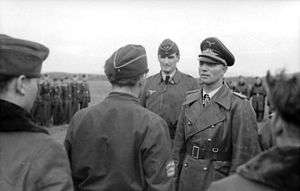Joseph Schmid
Joseph Beppo Schmid (24 September 1901 – 30 August 1956) was a German General serving in the Luftwaffe during World War II and recipient of the Knight's Cross of the Iron Cross, awarded by Nazi Germany for successful military leadership.
Joseph Schmid | |
|---|---|
 | |
| Born | 24 September 1901 Göggingen, Württemberg, German Empire |
| Died | 30 August 1956 (aged 54) Augsburg, Bavaria, West Germany |
| Allegiance | |
| Service/ | |
| Years of service | 1924–45 |
| Rank | Generalleutnant |
| Battles/wars | World War II |
| Awards | Knight's Cross of the Iron Cross |
Career
A close friend of Hermann Göring, Schmid commanded the Luftwaffe's Military Intelligence Branch (Abteilung 5 as Chief IC) from 1 January 1938 to 9 November 1942. Adolf Galland later criticized Schmid for doing nothing to upgrade the low quality of the intelligence service (actually, inventing intelligence situation data about British aircraft losses during Battle for Britain). In late 1942 he was put in charge of Division "General Göring" in Tunisia, known as Kampfgruppe Schmid. On personal orders from Göring, Schmid was flown out of the Tunisian pocket. Promoted to Generalmajor on 1 February 1943 and Generalleutnant on 1 July 1944 he was given command of the 1st Fighter Corps (15 September 1943 – 15 November 1944).[1] He was made commander of the Luftwaffenkommando West, formerly Luftflotte 3 on 23 November 1944. His leadership qualities were disputed to the end of the war, while Antony Beevor called him the "most disastrous intelligence officer the Wehrmacht ever produced".[2] Schmid commanded the German forces involved in Operation Bodenplatte on 1 January 1945. The German units charged with the Defense of the Reich fought under his leadership.[3]
Awards
- Iron Cross (1939) 2nd and 1st Class
- Knight's Cross of the Iron Cross on 21 May 1944 as Generalmajor and commander of the in Tunisia deployed detachment of the Division "General Göring"[4]
References
Citations
- Mitcham 2007, p. 107.
- Beevor 2016, p. 90.
- Obermaier 1989, p. 197.
- Scherzer 2007, p. 668.
Bibliography
- Beevor, Antony (2016). Ardennes 1944. London: Penguin. ISBN 9780241975152.
- Fellgiebel, Walther-Peer (2000) [1986]. Die Träger des Ritterkreuzes des Eisernen Kreuzes 1939–1945 — Die Inhaber der höchsten Auszeichnung des Zweiten Weltkrieges aller Wehrmachtteile [The Bearers of the Knight's Cross of the Iron Cross 1939–1945 — The Owners of the Highest Award of the Second World War of all Wehrmacht Branches] (in German). Friedberg, Germany: Podzun-Pallas. ISBN 978-3-7909-0284-6.
- Mitcham, Samuel W. (2007). Eagles of the Third Reich: Men of the Luftwaffe in World War II. Stackpole Books. ISBN 0-8117-3405-6.
- Obermaier, Ernst (1989). Die Ritterkreuzträger der Luftwaffe Jagdflieger 1939 – 1945 [The Knight's Cross Bearers of the Luftwaffe Fighter Force 1939 – 1945] (in German). Mainz, Germany: Verlag Dieter Hoffmann. ISBN 978-3-87341-065-7.
- Scherzer, Veit (2007). Die Ritterkreuzträger 1939–1945 Die Inhaber des Ritterkreuzes des Eisernen Kreuzes 1939 von Heer, Luftwaffe, Kriegsmarine, Waffen-SS, Volkssturm sowie mit Deutschland verbündeter Streitkräfte nach den Unterlagen des Bundesarchives [The Knight's Cross Bearers 1939–1945 The Holders of the Knight's Cross of the Iron Cross 1939 by Army, Air Force, Navy, Waffen-SS, Volkssturm and Allied Forces with Germany According to the Documents of the Federal Archives] (in German). Jena, Germany: Scherzers Militaer-Verlag. ISBN 978-3-938845-17-2.
| Military offices | ||
|---|---|---|
| Preceded by none |
Commander of 1. Jagdkorps 15 September 1943 – 30 November 1944 |
Succeeded by Generalleutnant Joachim-Friedrich Huth |